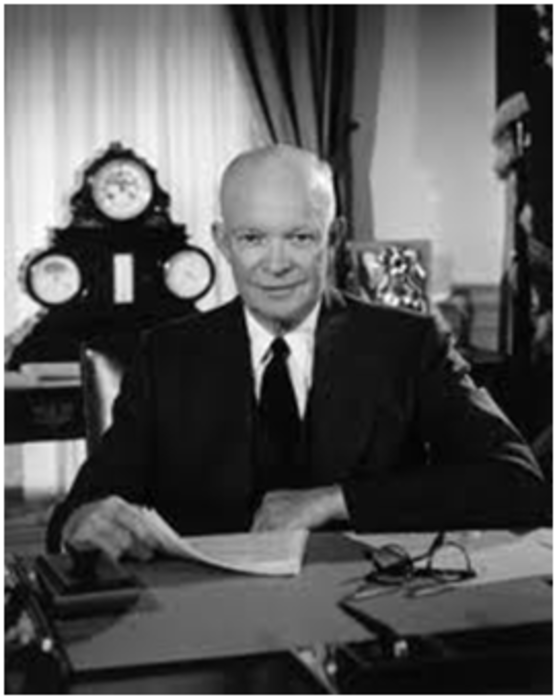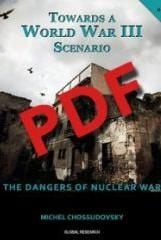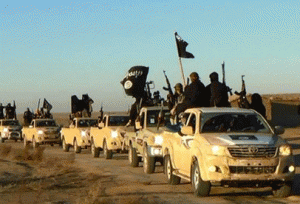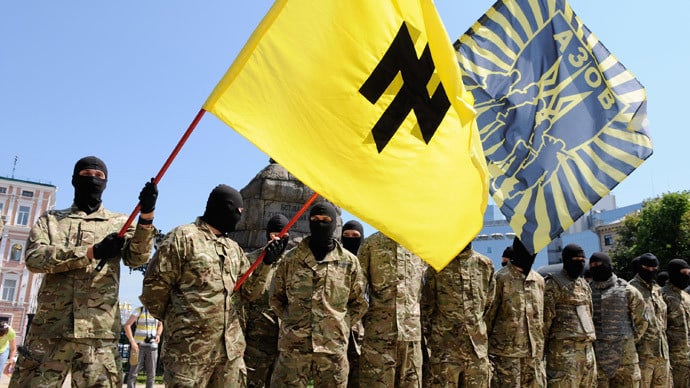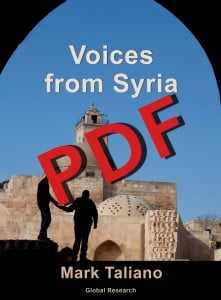All Global Research articles can be read in 51 languages by activating the “Translate Website” drop down menu on the top banner of our home page (Desktop version).
Visit and follow us on Instagram at @crg_globalresearch.
***
First published by Global Research on June 23, 20212
***
War against the Soviet Union was what Hitler had wanted from the beginning. He had already made this very clear in the pages of Mein Kampf, written in the mid-1920s. As a German historian, Rolf-Dieter Müller, has convincingly demonstrated in a well-documented study, it was a war against the Soviet Union, and not against Poland, France, or Britain, that Hitler was planning to unleash in 1939. On August 11 of that year, Hitler explained to Carl J. Burckhardt, an official of the League of Nations, that “everything he undertook was directed against Russia”, and that “if the West [i.e., the French and the British] is too stupid and too blind to comprehend this, he would be forced to reach an understanding with the Russians, turn and defeat the West, and then turn back with all his strength to strike a blow against the Soviet Union”. This is in fact what happened. The West did turn out to be “too stupid and blind”, as Hitler saw it, to give him “a free hand” in the east, so he did make a deal with Moscow — the infamous “Hitler-Stalin Pact” — and then unleashed war against Poland, France, and Britain. But his ultimate objective remained the same: to attack and destroy the Soviet Union as soon as possible.
Hitler and the German army commanders were convinced they had learned an important lesson from World War I. In 1918, in the final stages of World War I, mobile warfare resumed after years of stalemate in the trenches. That is when the Allies, whose unlimited access to colonial resources, including petroleum, had allowed them to construct and use thousands of tanks, trucks, and airplanes and thus “float to victory on a wave of oil”, as one of their leaders put it. Germany, on the other hand, had been prevented by a Royal Navy blockade from importing these vital raw materials, had therefore not provided its army with similar modern equipment and weapons, and thus went down to defeat.
Hitler and his generals knew that it would be impossible to win a new modern war without motorized equipment, but Germany had a highly developed industry, quite capable to produce huge numbers of tanks, airplanes, and trucks to transport the infantry. But fighting and winning a new modern war would also require sufficient stocks of strategic raw materials, especially petroleum and rubber, which Germany lacked. It was decided to tackle this crucial problem in two ways. First, by importing plenty of petroleum and rubber, creating huge stockpiles for use whenever the dogs of war would be unleashed and further imports were likely to be prevented by a new British blockade. Most of this came from the world’s greatest exporter of oil at the time, the US. Second, it was decided to start producing synthetic petroleum and rubber from coal, a raw material abundantly available in Germany.
These preparations were supposed to enable Germany to win the coming war. It was still considered vital to keep the war as short as possible, since the stockpiles of fuel were likely to dwindle fast, the potential for wartime imports (from friendly countries such as Romania) was limited, and synthetic rubber and oil could not be expected to be available in sufficient quantities. To win a new edition of the “Great War”, Germany would therefore have to win it fast, very fast. This is how the Blitzkrieg concept was born, that is, the idea of warfare (Krieg) fast as lightning (Blitz). The Blitzkriegapproach called for synchronised attacks by waves of tanks and airplanes to pierce the enemy’s defensive lines, behind which enemy troops could be expected to be massed; deep penetration into hostile territory; rapid movement of infantry units not on foot or by train, as in the Great War, but in trucks; and the German spearheads swinging back to bottle up and liquidate entire enemy armies in gigantic “encirclement battles”. Blitzkrieg meant motorized war, making full use of the massive numbers of tanks, trucks, and planes cranked out by German industry, but also burning gargantuan amounts of imported and stockpiled petroleum and rubber.
In 1939 and 1940, the Blitzkrieg duly worked its magic, as the combination of excellent equipment and plentiful fuel permitted the Wehrmacht and Luftwaffe to overwhelm the Polish, Dutch, Belgian, and French defences in a matter of weeks; Blitzkriege, “lightning-fast wars”, were invariably followed by Blitzsiege, “lightning-fast victories”. By the summer of 1940, Germany looked invincible and predestined to rule the European continent indefinitely. As for Britain, the German high command had never been asked to prepare plans to invade that country. Why not? Hitler had always yearned for a continental war against the Soviets and counted on British political leaders such as Chamberlain, known to be virulently anti-Soviet, to watch approvingly from the sidelines. London’s infamous policy of “appeasement” confirmed this expectation, until Chamberlain, under pressure from public opinion, felt compelled to side with Poland in its conflict with Hitler over Gdansk. Under these circumstances, Hitler decided to postpone his planned eastern war so he could deal with Poland and the Western powers first. That is why he proposed a deal to the Soviets, whose offers to establish a common anti-Hitler front had repeatedly been rebuffed by London and Paris. The infamous “Pact”, which they concluded with Hitler in August 1939, offered them extra space and time to prepare for a Nazi attack they knew to be merely postponed until a later date.

Clockwise from top left: German soldiers advance through Northern Russia, German flamethrower team in the Soviet Union, Soviet planes flying over German positions near Moscow, Soviet prisoners of war on the way to German prison camps, Soviet soldiers fire at German positions. (CC BY-SA 3.0)
Britain had gone to war, but very reluctantly. After his conquest of Poland and France (and the British army’s evacuation from Dunkirk), Hitler had reason to believe that the decision-makers in London would “see the light”, exit the war, and allow him to rule the European continent so that he could finally march eastward and crush the Soviet Union, while he would let Britain retain its overseas Empire. In London, however, the anti-Soviet (and filofascist) appeasers were replaced by Churchill, who, while also very anti-Soviet, was not willing to let Hitler control Europe; the new PM feared that after a victory against the Soviet Union, Hitler would be enticed – and very much enabled – to turn against Britain. Britain thus refused to be “reasonable”, as Hitler saw it, but could not hope to win the war on its own and had to fear that the German dictator might soon turn his attention to Gibraltar, Egypt, and/or other jewels in the crown of the British Empire.
The Reich’s triumphs were spectacular enough, but they depleted its fuel stockpiles while not yielding new sources of strategic raw materials, other than some minor oil wells in Poland. Under the terms of the 1939 Pact, however, Germany was supplied with petroleum by the Soviet Union. But how much? An awful lot, according to the conventional anti-Soviet or anti-Russian view, so much, according to one claim, that it was a precondition for the defeat of France in the spring of 1940. Despite these claims, according to Brock Millman’s thorough study, merely four percent of all German oil imports at that time originated in the Soviet Union. The reality is that, in 1940 and 1941, Germany relied mostly on petroleum imported from two countries. First, Romania, originally neutral but a formal ally of Hitler’s starting in November 1940. And second, the still-neutral US, whose oil barons exported huge amounts of “black gold”, mostly via other neutral countries such as Franco’s Spain; they would continue to do so until the US entered the war in December 1941, following the Japanese attack at Pearl Harbor. The Soviet deliveries of petroleum were of course useful to the Reich, but most troubling for Hitler was the fact that Germany had to reciprocate by supplying high-quality industrial products and state-of-the-art military technology, which was used by the Soviets to modernize their army and upgrade their defenses against a Nazi attack they were expecting sooner or later.
Another headache for Hitler was the fact that the terms of his Pact with the Soviets had made it possible for the latter to occupy eastern Poland, former Russian territory annexed by Poland during the Russian Civil War. They did so on September 17, 1939, when the Polish government fled to neutral Romania, thus abandoning the country and turning it into a “terra nullins”. The Soviet move was therefore in accordance with international law; as Churchill acknowledged, it did not amount to an act of war, did not turn the Soviet Union into an ally of Nazi Germany but allowed it to remain neutral, and for that reason it did not trigger a declaration of war by the Western powers, allies of Poland. Finally, if the Red Army had not occupied Eastern Poland, the Germans would have done so. This situation bothered Hitler. The Soviet border, and the country’s defences, had thus shifted a few hundred kilometres to the west, providing the Red Army with the defensive advantage of what is called a “glacis” in military jargon, a territorial “breathing space”; conversely, for the German military, the planned march to Moscow had thus become much longer.
The German dictator had a problem: the Soviets had gained valuable space, time was on their side, and their defences were getting stronger by the day. After the defeat of France, Hitler felt that he could not wait much longer before undertaking the mission he believed to be entrusted to him by providence, namely the annihilation of “Russia ruled by the Jews”. He had wanted to attack the Soviet Union in 1939, but had turned against the Western powers only, as German historian Rolf-Dieter Müller has put it, “in order to enjoy security in the rear when he would finally be ready to settle accounts with the Soviet Union”. Müller concludes that by 1940 nothing had changed as far as Hitler was concerned: “The real enemy was the one in the east”
Already in the fall of that year, after a failed attempt to have Churchill become “sensible” by means of bombing raids and a threatened invasion, he instructed his generals to forget Albion and plan for a great “Eastern War (Ostkrieg) in the spring of 1941. A formal order to this effect was issued on December 18, 1940. The project was code-named Operation Barbarossa (Unternehmen Barbarossa), after a famous German emperor and crusader. The choice of name reflected Hitler’s view of this coming conflict: it was to be a kind of holy war against the Soviet variety of communism, despised as a Jewish stratagem aimed at the overthrow of the natural superiority of the “Aryan” race. Such was the essence of Judeo-Bolshevism, a theory espoused not only by Hitler but also by countless influential political, economic, and intellectual leaders in Germany and throughout the Western world. One of them was Henry Ford, whose German branch plant was cranking out much of the equipment used by the German armed forces at the time, accumulating huge profits in the process.

Elements of the German 3rd Panzer Army on the road near Pruzhany, June 1941 (Public Domain)
Hitler felt that he could turn his gaze eastward without worrying too much about the British, who were still licking their wounds after a Houdini-like escape from Dunkirk. For two reasons, he was confident that their account could wait to be settled until after the completion of his primordial project, the Ostkrieg. First, that undertaking was to be yet another lightning-fast war, expected to last no more than two months; we will return to that issue very shortly. Second, unlike the previous German victories, a triumph against the Soviet Union was guaranteed to provide Germany with the virtually limitless resources of that huge country, including Ukrainian wheat to provide Germany’s population with plenty of food; minerals such as coal, from which synthetic oil and rubber could be produced; and — last, but certainly not least — the rich Caucasian oil fields, where the gas-guzzling Panzers and Stukas would be able to fill their tanks to the brim at any time. Steeled with these assets, it would be a sinecure for Hitler to deal with Britain.
Defeat of the Soviet Union would indeed have provided a “final solution” for Germany’s predicament, being an industrial superpower devoid of territorial possessions to provide strategic raw material. Possessing a huge “complementary territory” in the east, similar to America’s “Wild West” and Britain’s Indian colony, was certain to finally turn Germany into a genuine world power, invulnerable within a European “fortress” stretching from the Atlantic to the Urals. The Reich would possess limitless resources and would therefore be capable of winning even long, drawn-out wars against any antagonist — including the US — in one of the future “wars of the continents” conjured up in Hitler’s feverish imagination.
Hitler and his generals were confident that their planned Blitzkrieg against the Soviet Union would be as successful as their earlier lightning wars against Poland and France had been. They considered the Soviet Union to be a “giant with feet of clay”, whose army, presumably decapitated by Stalin’s purges of the late 1930s, was “not more than a joke”, as Hitler himself put it on one occasion. In order to fight and win the decisive battles, they allowed for a campaign of six to eight weeks, possibly to be followed by some mopping-up operations, during which the remnants of the Soviet host would “be chased across the country like a bunch of beaten Cossacks”. In any event, Hitler felt supremely confident, and on the eve of the attack, he “fancied himself to be on the verge of the greatest triumph of his life”.
In Washington and London, the military experts likewise believed that the Soviet Union would not be able to put up significant resistance to the Nazi juggernaut, whose military exploits of 1939–1940 had earned it a reputation of invincibility. The British secret services were convinced that the Soviet Union would be “liquidated within eight to ten weeks”, and the chief of the Imperial General Staff averred that the Wehrmacht would slice through the Red Army “like a warm knife through butter” and that the Soviet forces would be rounded up “like cattle”. According to expert opinion in Washington, Hitler would “crush Russia [sic] like an egg”.
Barbarossa started on June 22, 1941, in the early hours of the morning. The Soviet Union’s border was crossed by “the largest invasion force in the history of warfare” (Wikipedia), consisting of three million German soldiers and almost 700,000 troops contributed by allies of Nazi Germany, equipped with 600,000 motor vehicles, 3,648 tanks, more than 2,700 planes, and just over 7,000 pieces of artillery. At first, everything went according to plan. Huge holes were punched in the Soviet defences, impressive territorial gains were made rapidly, and hundreds of thousands of Red Army soldiers were killed, wounded, or taken prisoner in a number of spectacular “encirclement battles”. The road to Moscow seemed to lay open.
About the opening stages of Operation Barbarossa, a few tenacious myths need to be dispelled. First, it is not true that the German attack purported to pre-empt an offensive planned by the Soviets themselves. This notion was originally propagated by the Nazi regime, recycled post-1945 for anti-Soviet propaganda purposes, and revived from time to time now that the Cold War turns out not to be over after all. A German historian, Bianka Pietrow-Ennker, has convincingly demolished this “thesis of a preventive war” (Präventivkriegsthese). An attack on Germany would have been suicidal for the Soviets, since it was certain to trigger a declaration of war by Japan, Germany’s ally, forcing the Red Army to do battle against powerful enemies on two fronts.
Second, it is untrue that the Soviet leaders, usually referred to as “Stalin”, did not expect a German attack. They did, and had been preparing furiously for it, but they did not know when to expect it and always kept hoping that the attack would come later, rather than sooner, since preparations for a coming attack are never totally finished. Signals were received that the curtain would rise when it did, namely on June 22; however, similar signals had come in earlier but had proved to be false; there was no reason to think that this time it was different, and it was felt necessary not to provoke Hitler with troop movements along the border, since in the summer of 1914 the hasty mobilization of the Russian army in similar tense circumstances had triggered a German declaration of war.
In the months and especially weeks prior to June 1941, Goebbels’ propaganda machine and the Nazi secret service had been working hard, and successfully, to befuddle Moscow with conflicting and consuming signals, mainly the idea that their troop concentrations along the Soviet border, impossible to dissimulate, were intended to deceive the British, against whom a major operation was supposedly being planned. Conversely, the British were working hard to bring about a conflict between Germany and the Soviet Union, as this would obviously be in their interest. In these circumstances, trying to trick Moscow into making a misstep that could trigger hostilities was part of that strategy of deceit, which deserves a major study. In any event, the Soviet leaders knew the attack was coming and had been preparing for it, but they found it impossible to correctly interpret a kaleidoscope of signals and were tragically fooled into refusing to believe that the German attack was imminent until the bombs started to rain down on them in the early hours of June 22.
A third myth concerns the purge of a considerable number of commanders of the Red Army, including Marshal Mikhail Tukhachevsky. In the so-called “show trials” of 1937, these men were presumably falsely accused of treasonous activities, tortured so that they confessed, and executed or imprisoned, thus ridding Stalin of potential rivals but also eliminating countless capable and experienced high-ranking officers; this “decapitation” of the Red Army supposedly helps to explain its poor performance in the early stages of Barbarossa. While this loss undoubtedly exacted a toll, an ultimately more important consideration is the fact that it is now certain that a heterogeneous “bloc of oppositionists” did exist within the Soviet Union and that Tukhachevsky and the other defendants did in fact belong to it and were deeply involved in its treasonous activities, included contacts with German and Japanese agents. Their ultimate goal was to sabotage the Soviet defensive efforts when Germany and/or Japan would attack, and the traitors would be rewarded by being allowed to come to power in what was to remain of the Soviet Union or a Russian successor-state. Joseph Davies, the US ambassador to the Soviet Union at the time of the trials, believed the accused to be guilty.
In other words, Tukhachevsky and company would have done what a cabal of French generals and politicians with fascist sympathies are now known to have orchestrated in the spring of 1940: they deliberately opted for defeat at the hands of an “external enemy”, Nazi Germany, to be able to defeat the “internal enemy”, in the case of France the socialists, communists, and other leftist forces who had earlier formed the “Popular Front” government. France’s defeat made it possible for these French “Tukhachevskies” to install a fascist regime under Marshal Pétain, as French historian Annie Lacroix-Riz has convincingly demonstrated in two of her studies. The existence and collaboration of such a “fifth column” helps to explain Nazi Germany’s unexpectedly easy victory over France and, conversely, what in France itself is referred to as the country’s “strange defeat” in 1940. If Tukhachevsky’s “fifth column” in the Soviet Union had not been eliminated, the Red Army would undoubtedly have done much worse in June 1941 than it actually did, and it would probably have experienced a “strange defeat” similar to that of the French army one year earlier.
In the days and weeks following June 22, the German army advanced rapidly in three major directions, namely to Leningrad in the north, Kiev in the south, and Moscow in the centre, seemingly confirming the reputation of invincibility it had acquired in 1939 and 1940. It soon became evident, however, that the Blitzkrieg in the east would not be the cakewalk that had been expected. Facing the most powerful military machine on earth, the Red Army was predictably taking a major beating but, as propaganda minister Joseph Goebbels confided to his diary as early as July 2, also put up a tough resistance and hit back very hard on numerous occasions.
General Franz Halder, in many ways the “godfather” of Operation Barbarossa’s plan of attack, acknowledged that Soviet resistance was much stronger than anything the Germans had faced in Western Europe. Wehrmacht reports cited “hard”, “tough”, even “wild” resistance, causing heavy losses in men and equipment on the German side. More often than expected, Soviet forces managed to launch counterattacks that involved heavy losses but did slow down the German advance. Some Soviet units went into hiding in the vast Pripet Marshes and elsewhere, organized deadly partisan warfare (for which thorough preparations had been made during the time gained thanks to the 1939 Pact), and threatened the long and vulnerable German lines of communication. It also turned out that the Red Army was much better equipped than expected. German generals were “amazed”, writes a German historian, by the quality of Soviet weapons such as the Katyusha rocket launcher (a.k.a. “Stalin Organ”) and the T-34 tank. Hitler was furious that his secret services had not been aware of the existence of some of this weaponry.

German advances from June to August 1941 (Public Domain)
The greatest cause of concern, as far as the Germans were concerned, was the fact that the bulk of the Red Army managed to withdraw in relatively good order and eluded destruction in a huge encirclement battle, in the kind of repeat of Cannae or Sedan that Hitler and his generals had dreamed of. The Red Army commanders appear to have carefully observed and analyzed the German blitzkrieg successes of 1939 and 1940 and to have learned useful lessons. They must have noticed that in May 1940 the French had massed the bulk of their forces right at the border, behind the Maginot Line, as well as in Belgium, thus making it possible for the German war machine to encircle them. The Soviets did leave some troops at the border, of course, and these troops predictably suffered major losses during the opening stages of Barbarossa. But — contrary to what is claimed by some historians – the bulk of the Red Army was held back in the rear, avoiding entrapment. It was this “defence in depth” – facilitated by the 1939 acquisition of a “glacis”, a territorial “breathing space”, namely “Eastern Poland” – that frustrated the German ambition to destroy the Red Army in its entirety. As Marshal Zhukov was to write in his memoirs, “the Soviet Union would have been smashed if we had organized all our forces at the border”.
As early as the middle of July, as Hitler’s war in the east started to lose its Blitz-qualities, countless Germans, military as well as civilians, of low as well as high rank, lost their belief in a quick victory. Admiral Wilhelm Canaris, head of the Wehrmacht’s secret service, the Abwehr, thus confided on July 17 to a colleague on the front, General von Bock, that he saw “nothing but black”. On the home front, many German civilians also started to feel that the war in the east was not going well. In Dresden, Victor Klemperer, a Jewish linguist who kept a diary, wrote on July 13 that “we [the Germans] suffer immense losses, we have underestimated the Russians”.
Around the same time, Hitler himself abandoned his dream of a quick and easy victory and scaled down his expectations; he now expressed the hope that his troops might reach the Volga by October and capture the oil fields of the Caucasus a month or so later. By the end of August, at a time when Barbarossa should have been winding down, a memorandum of the Wehrmacht’s High Command (Oberkommando der Wehrmacht, OKW) acknowledged that it might no longer be possible to win the war in 1941.
A major problem was the fact that, when Barbarossa started on June 22, the available supplies of tires, spare parts, and above all fuel were good enough for only about two months. This had been deemed sufficient because it was expected that between six to eight weeks the Soviet Union would be on its knees and its unlimited resources — industrial and agricultural products as well as raw materials — would then be available to the Reich. But by late August the German spearheads were nowhere near those distant regions of the Soviet Union where petroleum, that most precious of all indispensibilia of modern warfare, was to be had. If the tanks managed to keep on rolling, though increasingly slowly, into the seemingly endless Russian and Ukrainian expanses, it was to a large extent by means of fuel and rubber imported, via Spain and occupied France, from the US.
The flames of optimism flared up again in September, when German troops achieved a major success by capturing Kiev and, farther north, made progress in the direction of Moscow. Hitler believed, or at least pretended to believe, that the end was now near for the Soviets. In a public speech in the Berlin Sportpalast on October 3, he declared that the eastern war was virtually over. The Wehrmacht was ordered to deliver the coup de grâce by launching Operation Typhoon (Unternehmen Taifun), an offensive aimed at taking Moscow. The odds for success looked increasingly slim, however, as the Soviets were busily bringing in reserve units from the Far East. (They had been informed by their master spy in Tokyo, Richard Sorge, that the Japanese, whose army was stationed in northern China, were no longer considering attacking the Soviets’ vulnerable borders in Vladivostok area.) To make things worse, the Germans no longer enjoyed superiority in the air, particularly over Moscow. Also, sufficient supplies of ammunition and food could not be brought up from the rear to the front since the long supply lines were severely hampered by partisan activity. Finally, it was getting chilly in the Soviet Union, though probably no colder than usual at that time of the year. The German high command, confident that their eastern Blitzkrieg would be over by the end of the summer, had failed to supply the troops with the equipment necessary to fight in the rain, mud, snow, and freezing temperatures of a Russian fall and winter.
Taking Moscow loomed as an extremely important objective in the minds of Hitler and his generals. It was believed, though probably wrongly, that the fall of its capital would “decapitate” the Soviet Union and thus bring about its collapse. It also seemed important to avoid a repeat of the scenario of the summer of 1914, when the seemingly unstoppable German advance into France had been halted in extremis on the eastern outskirts of Paris, during the Battle of the Marne. This disaster — from the German perspective — had robbed Germany of nearly certain victory in the opening stages of the Great War and had forced it into a lengthy struggle that, lacking sufficient resources and blockaded by the British navy, it was doomed to lose. This time, in a new Great War fought against a new archenemy, there was to be no new “miracle of the Marne”, that is, no faltering just outside the foe’s capital. It was imperative that Germany not find itself resourceless and blockaded in a long, drawn-out conflict it was doomed to lose. Unlike Paris, Moscow would fall, history would not repeat itself, and Germany would end up being victorious — or so they hoped in Hitler’s headquarters.
The Wehrmacht continued to advance, albeit very slowly, and by mid-November some units found themselves on the outskirts of Moscow, presumably even within sight of the towers of the Kremlin, but the troops were now totally exhausted and running out of supplies. Their commanders knew that it was simply impossible to take the Soviet capital, tantalizingly close as the city may have been, and that even doing so would not bring them victory. On December 3, a number of units abandoned the offensive on their own initiative. Within days, however, the entire German army in front of Moscow was simply forced on the defensive. Indeed, on December 5, at three in the morning, in cold and snowy conditions, the Red Army suddenly launched a major, well-prepared counterattack. The Wehrmacht’s lines were pierced in many places, and the Germans were thrown back between 100 and 280 kilometres with heavy losses of men and equipment; it was only with great difficulty that a catastrophic encirclement could be avoided. On December 8, Hitler ordered his army to abandon the offensive and to move into defensive positions. (As the Wehrmacht did actually make it to the western suburbs of Moscow in late 1941, it can be argued that they would almost certainly have taken the city, and perhaps won the war, had it not been for the concessions made by Hitler in the Pact of 1939, which resulted in the Soviet border being moved hundreds of kilometers to the west.)
In any event, it was in front of Moscow, in early December 1941, that Hitler’s Blitzkrieg against the Soviet Union ground to a halt. Thus ended not the war, of course, but the lightning-fast kind of war that was supposed to be the key to a German victory, the type of warfare that was to have enabled Hitler to realize his grand ambition, the destruction of the Soviet Union. More importantly, such a victory would also have provided Nazi Germany with sufficient petroleum and other resources to make it a virtually invulnerable behemoth. In the new “Battle of the Marne” just to the west of Moscow, Nazi Germany suffered the defeat that made victory impossible, not only victory against the Soviet Union itself, but also victory against Great Britain and victory in the war in general. It ought to be noted that the United States was not yet involved in the war.
Hitler and his generals had believed, not without reason, that to win a new edition of the Great War, Germany had to win it lightning-fast. But on December 5, 1941, it became evident to everyone present in Hitler’s headquarters that a lightning-fast triumph over the Soviet Union would not be forthcoming, and that Germany was doomed to lose the war, if not sooner, then later. According to General Alfred Jodl, chief of the operations staff of the OKW, Hitler realized on that very day that he could no longer win the war. And so it can be argued that the success of the Red Army in front of Moscow was unquestionably the “major break” [Zäsur] of the entire world war”, as Gerd R. Ueberschär, a German expert on the war against the Soviet Union, has put it. In other words, the tide of World War II turned on December 5, 1941. As real tides turn not suddenly but rather gradually and imperceptibly, the tide of the war turned not on a single day, but over a period of at least four months that elapsed between the summer of 1941 and early December of that same year.
The tide of the war in the east had been shifting extremely slowly, but it did not do so imperceptibly. Already in July 1941, less than one month after Operation Barbarossa got underway, well-informed observers had started to doubt that a German victory, not only in the Soviet Union but in the war in general, still belonged to the realm of possibilities. In that month, generals of Marshal Pétain’s French collaborator regime, meeting in Vichy, discussed confidential reports received from German colleagues about the situation on the eastern front. They learned that the advance into the Soviet Union was not going as well as expected and came to the conclusion that “Germany would not win the war but had already lost it”. From that moment on, a growing number of members of the French military, political, and economic elite discreetly prepared to leave the doomed ship Vichy; they hoped that their country would be liberated by the Americans, with whom contacts were established via sympathetic intermediaries such as the Vatican and Franco. Historian Annie Lacroix-Riz has described this development in detail.
In September, when the Blitzkrieg in the east was supposed to have been over, a correspondent of the New York Timesbased in Stockholm became convinced that the situation on the eastern front was such that Germany “might well collapse dramatically”. He had just returned from a visit to the Reich, where he had witnessed the arrival of trainloads of injured soldiers. And the always well-informed Vatican, initially very enthusiastic about Hitler’s “crusade” against the Soviet homeland of “godless” Bolshevism, became very concerned about the situation in the east in late summer 1941; by mid-October, it came to the conclusion that Germany would lose the war. (Clearly, the German bishops had not been informed of the bad tidings, since a couple of months later on December 10 they publicly declared to be “observing the struggle against Bolshevism with satisfaction”.) Likewise in mid-October, the Swiss secret services reported that “the Germans can no longer win the war”.
By late November, a defeatism of sorts had started to infect the higher ranks of the Wehrmacht and of the Nazi Party. Even as they were urging their troops forward towards Moscow, some generals opined that it would be preferable to make peace overtures and wind down the war without achieving the great victory that had seemed so certain at the start of Operation Barbarossa. And shortly before the end of November, armament Minister Fritz Todt asked Hitler to search for a diplomatic way out of the war, since purely militarily as well as industrially, it was as good as lost.
When the Red Army launched its devastating counteroffensive on December 5, Hitler himself realized that he would lose the war. But he was not prepared to let the German public know that. The nasty tidings from the front near Moscow were presented to the public as a temporary setback, blamed on the supposedly unexpectedly early arrival of winter and/or on the incompetence or cowardice of certain commanders. (It was only a good year later, after the catastrophic defeat in the Battle of Stalingrad during the winter of 1942-43, that the German public, and the entire world, would realize that Germany was doomed; which is why even today many historians believe that the tide turned at Stalingrad.) But it proved impossible to keep the catastrophic implications of the debacle in front of Moscow a total secret. For example, on December 19, 1941, the German Consul in the Swiss city of Basel reported to his superiors in Berlin that the (openly pro-Nazi) head of a mission of the Swiss Red Cross, sent to the front in the Soviet Union to assist the wounded only on the German side, which contravened Red Cross rules, had returned to Switzerland with the news, most surprising to the Consul, that “he no longer believed that Germany could win the war”.
In his headquarters deep in an East-Prussian forest, Hitler was still ruminating the catastrophic tiding when he received another surprise. On the other side of the globe, the Japanese had attacked the American naval base at Pearl Harbor, Hawaii, on December 7, 1941. The existing agreements between Berlin and Tokyo were defensive in nature and would have required the Reich to rally to the side of Japan if the latter had been attacked by the US, but that was not the case. Hitler had no such obligation to assist Japan, as has been claimed, or at least insinuated, in histories and documentaries about that dramatic event. Neither had the Japanese leaders felt compelled to declare war on Hitler’s enemies when he attacked Poland, France, and the Soviet Union. On each of these occasions, Hitler had not even bothered to inform Tokyo of his plans, no doubt out of fear of spies. The Japanese similarly neglected to let Hitler know of their plans to go to war against Uncle Sam. Nevertheless, on December 11, 1941, the German dictator did declare war on the United States. This seemingly irrational decision can only be understood in light of the German predicament in the Soviet Union. Hitler almost certainly speculated that this entirely gratuitous gesture of solidarity would induce his Far Eastern ally to reciprocate with a declaration of war on the enemy of Germany, the Soviet Union, and this would have forced the Soviets into the extremely perilous predicament of a two-front war. (The bulk of the Japanese army was still stationed in northern China and would therefore have been able to immediately attack the Soviet Union in the Vladivostok area.)
Hitler appears to have believed that he could exorcize the spectre of defeat in the Soviet Union, and in the war in general, by summoning a sort of Japanese deus ex machina to the Soviet Union’s vulnerable Siberian frontier. According to the German historian Hans W. Gatzke, the Führer was indeed convinced that “if Germany failed to join Japan [in the war against the United States], it would . . . end all hope for Japanese help against the Soviet Union”. But Japan did not take Hitler’s bait. Tokyo, too, despised the Soviet state, but the Land of the Rising Sun, now at war against the US, could afford the luxury of a two-front war as little as the Soviets. Tokyo preferred to put all of its money on a “southern” strategy, hoping to win the big prize of Southeast Asia – including petroleum-rich Indonesia and rubber-rich Indochina – rather than embark on a venture in the inhospitable reaches of Siberia. Only at the very end of the war, after the surrender of Nazi Germany, would it come to hostilities between the Soviet Union and Japan.
And so, through Hitler’s own fault, the camp of Germany’s enemies now included not only Great Britain and the Soviet Union, but also the mighty USA, whose troops could be expected to appear on Germany’s shores, or at least on the shores of German-occupied Europe, in the foreseeable future. The Americans would indeed land troops in France, but only in 1944, and in the Western world this unquestionably important event is still all too often glorified as the turning point of World War II. It is worth asking, however, whether the Americans would ever have landed in Normandy or, for that matter, ever have declared war on Nazi Germany, if Hitler had not declared war on them on December 11, 1941. And one should ask if Hitler would ever have made the desperate, even suicidal decision to declare war on the US if he had not found himself in a hopeless situation in the Soviet Union. The involvement of the US in the war against Germany, then, which for many reasons was not in the cards before December 1941, and for which Washington had not made any preparations, was also a consequence of the German setback in front of Moscow.
Nazi Germany was doomed, but the war was still to be a long one. Hitler ignored the advice of his generals, who strongly recommended trying to find a diplomatic exit and decided to battle on in the slim hope of somehow pulling victory out of a hat. The Russian counter-offensive would run out of steam in early January 1942, the Wehrmacht would survive the winter of 1941-42 and, in the spring of 1942, Hitler would scrape together all available forces for an offensive – code-named “Operation Blue” (Unternehmen Blau) – in the direction of the oil fields of the Caucasus. Hitler himself acknowledged that “if he did not get the oil of Maikop and Grozny, he would have to end this war”. But by then the element of surprise had been lost, and the Soviets disposed of huge masses of men, oil, and other resources, as well as excellent equipment, much of it produced in factories that had been established behind the Urals between 1939 and 1941. The Wehrmacht, on the other hand, could not compensate for the huge losses it had suffered in 1941. Between June 22, 1941, and January 31, 1942, the Germans had lost 6,000 airplanes and more than 3,200 tanks and similar vehicles. No less than 918,000 men had been killed, wounded, or gone missing in action, amounting to 28.7 per cent of the average strength of the army, or 3.2 million men. In the Soviet Union, Germany would lose no less than 10 million of its total 13.5 million men killed, wounded, or taken prisoner during the entire war, and the Red Army would end up claiming credit for 90 per cent of all Germans killed in the Second World War.
The forces available for a push toward the oil fields of the Caucasus were limited and, as it turned out, insufficient to achieve the objective. Under those circumstances, it is quite remarkable that in 1942 the Germans managed to make it as far as they did. The beast had been mortally wounded, but it would take a long time before it breathed its last, and it would remain powerful and dangerous until the end, as the Americans were to find out in the winter of 1944-1945 at the Battle of the Bulge. But when the Germans’ offensive inevitably petered out, namely in September 1942, their weakly held supply lines were stretched along many hundreds of kilometres, presenting a perfect target for a Soviet counterattack. When that attack came, it caused an entire German army to be bottled up and, after a titanic battle, to be destroyed at Stalingrad. After this great victory of the Red Army, the ineluctability of German defeat in World War II was obvious for all to see. The failure of the eastern Blitzkrieg in the second half of 1941, culminating in defeat in front of Moscow in early December of that year, had been the precondition for the admittedly more spectacular German Götterdämmerung at Stalingrad.
There are even more reasons to proclaim December 1941 as the turning point of the war. The Soviet counter-offensive destroyed the reputation of invincibility in which the Wehrmacht had basked ever since its success against Poland in 1939, thus boosting the morale of Germany’s enemies everywhere. In France, for example, the Resistance became bigger, bolder, and much more active. Conversely, the fiasco of the Blitzkrieg demoralized the Finns and other German allies. And neutral countries that had sympathized with Nazi Germany now became benevolent towards the “Anglo-Americans”. Franco, for example, sought to ingratiate them by averting his gaze as downed allied airmen, assisted by the French Resistance, technically violated Spanish neutrality by crossing the country from France to Portugal on their way back to Britain. Portugal, also officially neutral but on friendly terms with Britain, even allowed the British and Americans to use an air base on the Azores, which was to prove extremely useful in the Battle of the Atlantic.
Most importantly, the Battle of Moscow also ensured that the bulk of Germany’s armed forces would be tied to an eastern front of approximately 4,000 kilometres for an indefinite period of time and thus require the bulk of available strategic resources, above all petroleum. This all but eliminated the possibility of new German operations against the British. It made it impossible to supply Rommel in North Africa with sufficient men and materiel, and this ultimately led to his defeat in the Battle of El Alamein in the fall of 1942.
The tide of the war turned in the Soviet Union in 1941 Had the Soviets not been able to stop the Nazi juggernaut, Germany would almost certainly have won the war, because it would have gained control of the petroleum fields of the Caucasus, the rich agricultural lands of Ukraine, and many other vitally important resources. Such a triumph would have transformed Hitler’s Reich into an inexpungable superpower, capable of waging even long-term wars against anyone, including an Anglo-American alliance. Without the Soviet achievement in 1941, the liberation of Europe, including the liberation of Western Europe by the Americans, British, Canadians, etc., would never have taken place. During the landings in Normandy in June 1944, the western allies had a tough time, even though they faced only a fraction of the Wehrmacht and the Luftwaffe was impotent because of lack of fuel. But without the successes of the Red Army, first in front of Moscow and later at Stalingrad, the entire Wehrmacht would have been available in Normandy, the Luftwaffe would have had plenty of Caucasian fuel, and the landings would simply not have been feasible. Had the Red Army not prevented the success of Operation Barbarossa, Nazi Germany would have established its hegemony over Europe and would very likely have maintained it until the present time. Today, on the continent, the second language would not be English, but German, and in Paris the fashionistas might well promenade up and down the Champs Elysees in lederhosen.

German advances during the opening phases of Operation Barbarossa, August 1941 (Public Domain)
In 1943, after victories in Stalingrad in the spring and Kursk in the summer, it was obvious that, slowly but surely, the Red Army was on its way to Berlin. That is when the Americans and British, who had been sitting on the sidelines as a titanic war raged along the eastern front, decided it was high time to open a “second front” in France, so the Soviets would not defeat Nazi Germany and liberate all of Europe on their own – and reap the benefits of that achievement. While it must be acknowledged that, in the final year of the war, following the Normandy landings, the Americans and the other western allies did make a significant contribution to the victory over Nazi Germany, that triumph was due in the very first place to the herculean efforts and huge sacrifices made by the Russian and other peoples of the Soviet Union during four long years, starting on that fateful 22nd of June, 1941.
Let us briefly examine two myths about the historical fact that the Soviet Union was the first country to defend successfully against a Blitzkrieg-style attack launched against it by Hitler – and ultimately to vanquish Nazi Germany.
First, the fable that the Nazi invaders of the Soviet Union were defeated by “General Winter”. The Germans were defeated by the Red Army, with the support of the majority of the many peoples that made up the Soviet nation, except, of course, a not inconsiderable number of collaborators. Of the latter, every country facing the Reich unfortunately had its fair share. The Germans wrongly believed that the Soviet Union would be full of them, so that they would be welcomed with open arms as liberators, but the opposite proved to be the case: they faced widespread resistance, including armed resistance by partisans, and it is fair to say that without such popular support, the Soviet Union would not have survived the Nazi onslaught. This factor, combined with the tough resistance put up by the Red Army, caused Barbarossa to progress much more slowly than expected and failed to finish by the end of the summer, as Hitler and his generals had expected. This means that, by September 1941 at the latest, the Blitzkrieg strategy that was supposed to be the key to a German victory had failed. It took a few more months, until December 5, in early winter, for this failure to be certified, so to speak, by the start of the Soviet counter-offensive in front of Moscow; but as far as Germany was concerned, the fatal damage had already been done in the summer.
The myth crediting “General Winter” was originally concocted by the Nazis to rationalize their defeat in the Battle of Moscow, signifying the fiasco of Operation Barbarossa. Nazi spin doctors presented the nasty tidings to the public in Germany and in occupied Europe as a temporary setback, to be blamed on the supposedly unexpectedly early arrival of winter. After 1945, in the context of the Cold War, this myth was kept alive as part of the effort to minimize the Soviet contribution to the defeat of Nazi Germany. Finally, following the demise of the Soviet Union, the notion has been kept alive in the West because of its usefulness for anti-Russian purposes.
According to a second tenacious myth, the Soviets only managed to survive the Nazi onslaught thanks to massive material support provided by Uncle Sam in the context of the famous Lend-Lease program of aid to America’s allies. A number of facts demonstrate that this story, while woven around some historical facts, as myths usually are, also fails to do justice to the historical reality.
First of all, Uncle Sam was not an ally of the Soviet Union at the time of the Red Army counterattack in front of Moscow, in early December 1941, which confirmed the failure of a Blitzkrieg-strategy that was to have been the key to a German victory. The US was still a neutral country, and its upper class sympathized with the Nazis and with fascism in general and despised the Soviets and communism as a rule. In fact, a considerable number of rich, powerful, and very influential Americans – industrialists, bankers, members of Congress. generals, religious leaders, etc. – eagerly anticipated the defeat of the homeland of anti-capitalist and “godless” Bolshevism. It was only when, on December 11, 1941, a few days after Pearl Harbor, Hitler gratuitously declared war on the US, that Uncle Sam found himself to be an enemy of Nazi Germany and therefore an ally not only of the British but also of the Soviets, and that the flames of American anti-Sovietism were not quite extinguished, but temporarily dimmed.
Second, as for American aid to the Soviet Union, there was none at all in 1941, the year that ended with a reversal of the tide of war. Moscow asked the US to supply equipment from the very start of Barbarossa but failed to receive a positive response. After all, in the US too, it was expected that the Soviet Union was going to collapse soon. The American ambassador in Moscow even warned emphatically against sending aid, arguing that in view of the impending Soviet defeat, these supplies would fall into German hands.
The situation changed in the late fall of 1941, when it became increasingly clear that the Red Army would not be “crushed like an egg”. In fact, the Soviets’ tough resistance demonstrated that they were likely to be a very useful continental ally to the British, with whom American businessmen and bankers were engaging in extremely profitable Lend-Lease business. Extending Lend-Lease aid to the Soviets – which meant sales, not a free gift, of equipment – now promised to generate even more profits. The New York Stock Exchange started to reflect this fact of life: the quotations rose as the Nazi advance into Russia slowed down. It was in this context that a Lend-Lease agreement was signed by Washington and Moscow in November 1941, but it would take many more months before deliveries were to start trickling in. A German historian, Bernd Martin, has emphasized that throughout 1941 American aid to the Soviet Union remained purely “fictitious”. American material assistance thus became meaningful only in 1942 or arguably even 1943, that is, long after the Soviets had singlehandedly ruined Nazi Germany’s prospects for victory – while using their own weapons and equipment. According to British historian Adam Tooze, “the Soviet miracle owed nothing to western assistance [and] the effects of Lend-Lease had no influence on the balance of forces on the Eastern Front before 1943”.
Third, American aid would never represent more than 4 to 5 per cent of total Soviet wartime industrial production, although it must be admitted that even such a slim margin might prove crucial in a crisis situation. Fourth, the Soviets themselves cranked out all of the light as well as heavy high-quality weapons that made their success against the Wehrmacht possible.
Fifth, and probably most importantly, the much-publicized Lend-Lease aid to the USSR was to a large extent neutralized, and possibly even dwarfed, by the massive and very important aid provided to Nazi Germany not by the American state but by US corporations. But this US assistance to Hitler was unofficial, the public was unaware of it, and it has remained off the radar screens of most historians until the present day. Not surprisingly, the few historians who have drawn attention to it have been ignored by their mainstream colleagues and by the media. This story is too long and complex to be dealt with here, but it is essential to know that branch plants of US corporations such as Ford, GM, IBM, ITT, and Singer remained active in Germany before and even after Pearl Harbor; they cranked out trucks, airplanes, communications equipment, machine guns, and plenty of other martial equipment for use by the Nazi armed forces, and made a lot of money in the process.
In 1941, moreover, American oil firms and trusts were still delivering huge amounts of petroleum to Nazi Germany via neutral states such as Spain. The American share of Germany’s oil imports was in fact increasing rapidly; in the case of vitally important oil for engine lubrication, for example, from 44 per cent in July to no less than 94 per cent in September. The tens of thousands of Nazi planes, tanks, trucks, and other war machines involved in the invasion of the Soviet Union, many of them produced by US firms, were largely dependent on fuel supplied by American oil trusts. In view of the depletion of the stockpiles of petroleum products at that time, it is fair to say that the German Panzers would probably never have made it all the way to the outskirts of Moscow without fuel supplied by American oil trusts, as has been argued by the German historian Tobias Jersak. In light of this, the notion that US aid helped the Soviet Union to survive Barbarossa comes close to being laughable.
Hitler had code-named his attack on the Soviet Union after a medieval German emperor and crusader, Frederick I, known as Barbarossa, “Redbeard”. And he had opted to launch the attack on June 22, that is, the day after the summer solstice. Symbolically, these were two poor choices, conjuring up failure, defeat, and death. The Third Crusade, the one Barbarossa embarked upon, was far from successful and the emperor perished ingloriously while leading it, drowning while taking a bath in a river in Anatolia; and his body received a rather strange burial, with the skeleton, heart, and other parts ending up in different burial places in Outremer, the Middle-Eastern land of the crusaders’ enemies. As for June 22, that is the day when the sun’s annual trajectory, having reached a high point the previous day, the day of the summer solstice, takes a downward turn. Prior to the start of Operation Barbarossa, Hitler’s sun had been rising steadily, and in the spring of 1941, after new victories in the Balkan, it had in fact reached what he believed was yet to come: its zenith; however, starting on June 22, it started to decline, slowly and almost invisibly at first, but perceptibly so after only a few months if not weeks. Hitler’s sun was to set slowly, but inexorably, and total darkness was to set in during the spring of 1945. To avoid being taken prisoner, Hitler committed suicide, and he ordered his body to be burned. However, the lack of fuel that would have been plentiful had Operation Barbarossa been successful, caused that job to be botched, and his corpse did not fare any better than that of Barbarossa. The charred remains were scraped together by the Soviets and shipped to Moscow. There, in the middle of the capital of the land of his archenemies, the Jerusalem of communism, he had looked forward to celebrating the success of Operation Barbarossa by overseeing a parade of German soldiers goose-stepping on Red Square. But as a result of the failure of his crusade, the few bits and pieces that were left of him, fragments of his jawbone and skull, ended up occupying a shoebox on a shelf in a Moscow archive.
*
Note to readers: Please click the share buttons above or below. Follow us on Instagram, @crg_globalresearch. Forward this article to your email lists. Crosspost on your blog site, internet forums. etc.
Dr. Jacques R. Pauwels is author of Big Business and Hitler (Toronto, James Lorimer, 2015), The Myth of the Good War: America in the Second World War (second edition, Toronto, James Lorimer, 2017), and The Great Myths of Modern History (forthcoming).
